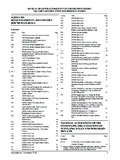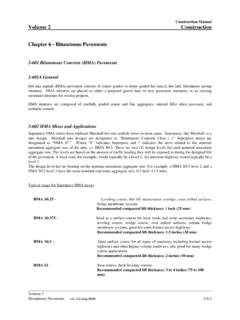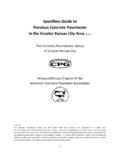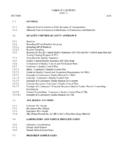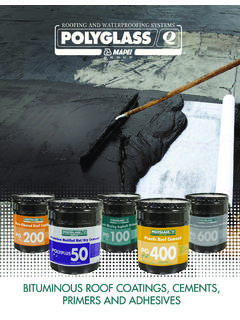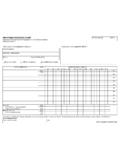Transcription of GUIDELINES FOR SUPERPAVE BITUMINOUS CONCRETE MIXES
1 Revised: 06/05/2017 GUIDELINES FOR SUPERPAVE BITUMINOUS CONCRETE MIXES SUPERPAVE Traffic Level Rationale For each nominal maximum aggregate size, the SUPERPAVE design method contemplates four traffic levels which are based on the accumulated traffic to which they will be subjected over their in-service life. The accumulated traffic in the SUPERPAVE design method is characterized by standardizing the axle loads into an equivalent number of repetitions of a single, 18-kip reference axle. These loads, called Equivalent Single Axle Loads (ESALs) are accumulated over the design life of the pavement and determine which SUPERPAVE traffic level is used.
2 The higher the volume of traffic of the roadway, the higher the number of ESALs, and the higher the SUPERPAVE traffic level of the mix. Consequently, a substantial length of interstates and expressways would require a SUPERPAVE Traffic Level 4 mix, whereas many secondary roadways with low traffic loadings would be best served by SUPERPAVE Traffic Level 2 MIXES . (Note: The state of the art in traffic characterization for pavement design is to consider load spectra instead of ESALs to measure the cumulative effect of traffic loadings on a pavement structure.)
3 This is part of the upcoming AASHTO Mechanistic Pavement Design Guide.) The Connecticut Department of Transportation has reduced the number of SUPERPAVE traffic levels needed for the state roadway system to two Traffic Level 2 and Traffic Level 3. Traffic Level 1 and Traffic Level 4 mix design requirements were eliminated due to very low demand for these MIXES on the state roadway system. However, Traffic Level 4 mix characteristics are still needed on a few select, high volume roadways. Traffic Level 4 design characteristics can be achieved by stiffening the high temperature end of the asphalt binder and applying that to a Traffic Level 3 aggregate structure.
4 By altering the binder only, Traffic Level 4 performance characteristics can be achieved. This is typically accomplished by the addition of a polymer modifier. When a polymer is added, the BITUMINOUS CONCRETE shall be designated as Polymer Modified Asphalt (PMA) and should be specified, measured, and paid for under the appropriate PMA item. Modified SUPERPAVE BITUMINOUS CONCRETE MIXES The term modified in this context refers to any BITUMINOUS CONCRETE that has been altered from its normal/original/neat state. Almost always it is the liquid asphalt binder that is modified or altered from its original state.
5 During a typical refining process, the asphalt binder created or generated is most commonly PG 64S -22 with PG referring to performance grade, S referring to standard, 64 referring to the upper temperature performance limit in degrees Celsius, and -22 ( negative 22 ) referring to the lower temperature performance limit (o C). The upper limit is the average 7-day maximum design temperature and the lower limit is the 1-day minimum design temperature. Much like multi-grade motor oils, asphalt binders are manufactured and formulated to perform over various temperature ranges.
6 Revised: 06/05/2017 Various refining methods and strategies can produce varying grades of liquid asphalt binders, but there are limitations to the performance grades that can be achieved through the refining process alone. Using other modification technologies allows asphalt producers to extend the performance characteristics of commonly produced asphalts. There are different reasons for modifying liquid asphalt binders used in hot mix asphalts. The two primary forms of asphalt modification currently being used by the Department are 1) Polymer Modified Asphalt and 2) Warm Mix Asphalt.
7 1) Polymer Modified Hot Mix Asphalt (Polymer Modified Asphalt PMA) Polymer is a technical word for plastic. Plastics can be formulated to have certain strength and stiffness characteristics throughout all types of temperature ranges. When the right polymer, at the right amount, is added to asphalt it can greatly enhance the properties of the asphalt without any detrimental effect to any other performance characteristic. Higher volume roadways see more trucks and other heavy vehicles and are susceptible to rutting during the hot summer months.
8 Asphalt softens with increases in temperature. It is when temperatures are hottest and traffic is the heaviest that asphalt pavements are most vulnerable to deformation (flushing, bleeding, rutting, and shoving). There are two ways to stiffen BITUMINOUS CONCRETE make the aggregate interlock stronger and/or stiffen the binder properties at higher temperatures. Substituting a more effective binder one that is stiffer at high temperatures is the easiest and most effective way to accomplish this. And it provides other additional benefits such as increased durability and increased resistance to cracking.
9 Strengthening the aggregate matrix, while increasing the mix s ability to withstand high temperature loading, typically leads to a reduction in asphalt content to make room for more tightly packed aggregate. Lower asphalt contents cause many detrimental effects to the durability of the BITUMINOUS CONCRETE . This makes polymer modification of liquid asphalt the best choice. The standard SUPERPAVE binder (PG 64S -22) can be modified to create other PG grades, primarily ones that are stiffer on the high temperature end of their grade, while still maintaining the low temperature grade desired.
10 For example, a relatively small amount of polymer can be added to generate a PG 64E -22, which essentially performs like a PG 76 -22. The E in this case stands for extreme. A PG 76 -22 binder has the same low temperature performance as a PG 64 -22, but better rut resistance and durability at higher temperatures approaching 76 degrees Celsius. A Traffic Level 3 mix design using PG 64E -22 will generally deliver the same rut resisting performance as a Traffic Level 4 SUPERPAVE mixture with PG 64S -22, without reducing the asphalt content.










